
What’s this all about, Jordi wants to know.
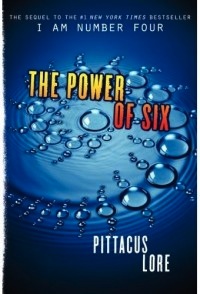 “The Power of Six,” published in August 2011, is the second book of the Lorien Legacies. The first, “I Am Number Four,” was published in August 2010 and a movie appeared in early 2011 (it was quite good–read my review).
“The Power of Six,” published in August 2011, is the second book of the Lorien Legacies. The first, “I Am Number Four,” was published in August 2010 and a movie appeared in early 2011 (it was quite good–read my review).
The series centers around 9 children from the planet Lorien, which is destroyed by the evil Mogadorians. These 9 (called Garde), along with an adult guardian/warrior (called Cepan), escape to earth, where they hide out. These nine children are special; they will, in time, develop “legacies,” which are super powers. And, according to the plan, they will ultimately defeat the Mogadorians and restore Lorien.
The Mogadorians know they are on earth, and are hunting them tenaciously. However, a charm requires that these nine be killed in order, from one to nine. In “I Am Number Four,” the first three have been killed, and now they are after “John Smith,” who is number four. When a Garde is killed, a tattoo of sorts automatically burns into the skin of each remaining Garde, so they all know how many are left.
I really enjoyed “I Am Number Four,” and felt the author did well in crafting the whole mythology and backstory.
I may have liked “The Power of Six” even better.
I initially assumed that the title referred to the child numbered 6, a girl who came to John Smith’s rescue in the first book. Actually, it probably has a double meaning–the power of that girl, yes, but also the combined power of the remaining six.
The book begins in Spain with Marina, who is number 7. She and her guardian have been hiding out in a convent/orphanage. Marina, using the internet, sees stories about John Smith and guesses that he is number 4. She yearns to connect with the others, who were all intentionally scattered upon arriving on earth. Marina realizes Mogadorians have tracked her down, but her Cepan has embraced Catholicism and is in dangerous denial–an emotional breakdown of sorts, after years of hiding throughout Europe–that there is a Mogadorian threat. Marina is on her own.
In the USA, John Smith is on the run (from police and from the Mogadorians) with Six and Sam, a human from the first book. They have a series of violent run-ins with Mogadorians, who keep tracking them down. Plenty of action here, much more than in the first book.
The book alternates between Spain and the US, with each part told first-person (by Marina and John Smith).
Nothing is resolved in this book–it’s a series, after all. But we do learn a lot. We learn about how the charm works, requiring that the Garde be killed in order, and what happens if someone tries to kill one out-of-order. I was wondering how that worked.
We learn more of the back-story of Lorien and the whole mission of the Garde (including what happened to Numbers One, Two, and Three). Much, much is explained. We learn a great deal, and I found myself much more engrossed in the whole thing.
We learn what happened to Six before she suddenly arrived on the scene in Book One–her Cepan killed, herself imprisoned in a vast underground Mogadorian complex in West Virginia.
Both parts are told first-person, by Marina and John Smith. And there is a concluding show-down in both Spain and the US. That’s not giving anything away (to give something away, I would need to tell you the results of those showdowns).
I really enjoyed this book, and devoured it quickly on my Nook Color. I eagerly await the third installment. I should emphasize that this is juvenile fiction (or young adult), which means it’s clean. Another plus.
Okay, Fort Wayne people. I’ve compiled my favorite foods from Fort Wayne area restaurants. I called them “favorite” rather than “best,” because there are many restaurants I’ve not got around to trying. I can only speak to my personal favorites.
So if you’ve got a favorite in one of these categories, chime in. I’m always interested in where to find great food.
Favorite ribs: Texas Roadhouse. Honorable mention:: brown sugar ribs at Smokey Bones.
Favorite sandwich: Frisco melt at Steak ‘n Shake. Honorable mention: New Orleans sandwich at McAlister’s Deli.
Favorite dessert: Maple Butter Blondie at Applebees. Honorable mention: donuts at Smoke Bones.
Favorite salad: Oriental chicken salad at Applebees. Honorable mention: Casa Ristorante and Olive Garden.
Favorite hamburger: the double at Five Guys.
Favorite fish: Crispy Tilapia at Don Halls Tavern at Coventry.
Favorite appetizer: pretzel bones at Smokey Bones.
Favorite coney dogs: Dog & Suds.
Favorite wings: Buffalo Wings & Ribs. Honorable mention: smoked wings at Smokey Bones.
Favorite pasta: garlic shrimp oreganata at Biaggis.
Favorite dinner bread: Biaggis.
Favorite rolls: Logans.
Favorite sub: club at Penn Station.
Favorite onion rings: Flannigans.
Favorite tea: peach tea at Smokey Bones. Honorable mention: McAlister’s Deli.
Favorite donuts: iced cruller and vanilla cream filled long johns at Scotts.
Favorite french fries: curly fries at Buffalo Wings & Ribs. Also: Steak ‘n Shake and Penn Station.
Favorite steaks: Prime Rib at Don Hall’s Guesthouse. Also: campfire steak at Red River Steakhouse.
Favorite breadsticks: Fazolis.
Favorite soup: potato cheese soup at Red River Steakhouse. Honorable mention: chicken and wild rice at Panera Bread.
Favorite lasagna: Casa Ristorante.
Favorite ice cream: Zesto vanilla.
Favorite pizza: Pizza Junction in Huntington. Honorable mention: Hungry Howie’s with butter-cheese crust.
Favorite pancakes: Spyros.
Also worth mentioning: brisket at Red River Steakhouse, dumplings at Cracker Barrel,
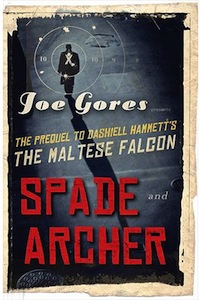 I didn’t have high hopes for “Spade and Archer,” even though it is published under the Black Lizard imprint, which rarely disappoints. A prequel to Dashiell Hammett’s classic “The Maltese Falcon”? Really? Who exactly is Joe Gores? And who gave him permission to use Hammett’s characters?
I didn’t have high hopes for “Spade and Archer,” even though it is published under the Black Lizard imprint, which rarely disappoints. A prequel to Dashiell Hammett’s classic “The Maltese Falcon”? Really? Who exactly is Joe Gores? And who gave him permission to use Hammett’s characters?
Actually, Hammett’s surviving daughter gave permission. Gores approached her in 1999 about doing a prequel, and she said no. Then in 2004, she approached him about a sequel. He said no, but restated his interest in writing a prequel. She finally said yes in 2006, and the book was published in 2009.
When “The Maltese Falcon” opens, Sam Spade had been a detective for many years. Gores says, “I wanted to find out for myself who Sam Spade was when he started out–how did he become this iconic figure? Every private eye who I’ve known, including myself, thinks Sam Spade is the ideal detective.”
Spade set the pattern for hundreds of private eyes to come (most notably, Philip Marlowe and Lew Archer). He prefers to work alone. He has a love-hate relationship with cops (usually on their bad list). He’s a tough guy.He’s a ladies’ man. He notices things other people miss. He flaunts a sarcastic wit. And he doesn’t mind working outside the law. Gores brings all of this to vivid life.
The book spans a seven-year period, 1921-1928. The book begins as Sam Spade, after serving in World War I, is concluding his final case with the Continental Detective Agency. Spade sets up his own detective agency in San Francisco, and brings aboard Effie Perine as his, as they would say today, administrative assistant.
The book has three parts–the first cases in 1921 (a gold heist and a runaway boy), a second batch in 1925, and a final set in 1928 after Archer joins the firm (these involving thievery on the waterfront and lost money raised for Chinese leader Sun Yat-sen). The opening case involved gold stolen from a ship which had just arrived in San Francisco harbor from Australia via Hawaii. From this case emerges a villain named St. Claire McPhee who gets away, but who is never forgotten by Spade. He keeps arising as we go through the book. That gives a continuity thread.
The cases are all quite interesting, and not so complicated (as are some of Hammett’s plots) that you lose track of what’s happening.
About two-thirds of the way through the book, Miles Archer, an old friend, joins the firm. Spade and Archer’s gorgeous wife, Iva, have periodic flings. Though, since Gores is writing in the style of Hammett, the trysts are only implied and always off-camera.
Another reviewer, Dan Faust, wrote, “Gores manages to do something that Hammett couldn’t: he got me to connect with Sam Spade.”
I completely agree. The Spade drawn by Gores is a much more interesting and fully developed character than Hammett gave us. After finishing this book, I read the short story, “A Man Called Spade,” one of three short stories about Spade written after “The Maltese Falcon” (because fans clamored for more Spade, and Hammett needed the money). That piece didn’t tell me much about Spade. Instead, I found myself inserting the mental picture of the man I crafted from reading “Spade and Archer.”
Bottom line: I really, really liked “Spade and Archer.” The plots–a series of plots, all dispatched in good time–were interesting and easy to follow. I found myself feeling like I was in 1920s San Francisco (Gores obviously did bountiful research).
The book ends with Effie Perine announcing the arrival of a potential new client, Wonderly, who gets “The Maltese Falcon” started. The last few paragraphs of “Spade and Archer” are identical to the opening paragraphs of “The Maltese Falcon.” That was a nice touch, and does nothing to spoil for you “Spade and Archer.”
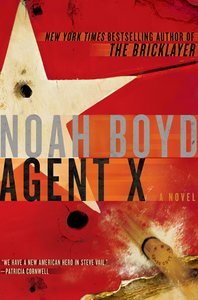 “Agent X” (February 2011) is the second bestselling novel under the name Noah Boyd, which is a pen name of Paul Lindsey. Lindsey, who wrote a total of 7 novels, served as a Marine officer in Vietnam and then worked 20 years with the FBI. Unfortunately, he died at age 68 in September 2011 after a battle with leukemia. So this series may go no further.
“Agent X” (February 2011) is the second bestselling novel under the name Noah Boyd, which is a pen name of Paul Lindsey. Lindsey, who wrote a total of 7 novels, served as a Marine officer in Vietnam and then worked 20 years with the FBI. Unfortunately, he died at age 68 in September 2011 after a battle with leukemia. So this series may go no further.
Both Noah Boyd books revolve around former FBI agent Steve Vail, who now works as a freelance bricklayer in Chicago (thus the title of the first Boyd book, “The Bricklayer“). In both books, he gets dragged into complex criminal plots, and works alongside FBI agent and love interest Kate Bannon. They are an interesting team.
The defining characteristic of Vail is that he distrusts authority–especially in the FBI, which burned him. He’s the prototypical loner, the anti-establishment hero who gets things done by working outside the system. Think of a cerebral Dirty Harry with an FBI badge.
In Agent X, a Russian spy known as Calculus offers to give the FBI a list of Americans who are trading secrets to the Russians. Calculus is recalled to Moscow, a sign that he’s been found out. But Calculus left a series of cryptic clues–extremely cryptic–to the identities of the American traitors. The FBI needs to find these moles before the Russians start killing them off (to avoid embarrassment at being caught spying).
Vail comes to Washington DC to see Kate Bannon, and both are recruited for this urgent investigation. The American turncoats keep getting killed, and there are gun battles with the bad guys. But they keep at it.
The plot is quite complex. Calculus left very complicated clues, but Vail, of course, cracks them. However, things get so complicated that I, simpleton reader that I am, got confused at various stages. In some cases, I just gave up trying to keep things straight or understand what was happening, figuring it probably didn’t matter. And it didn’t. It would have been a better book, and much more believable, without this treasure hunt.
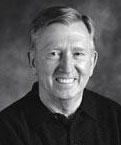
Paul Lindsey, aka Noah Boyd
“Agent X” tells us a lot more about about Steve Vail, helping us understand why he is the way he is. That was nice. The relationship with Kate Bannon is quite back-and-forth and charged in this book (as it was, actually, in “The Bricklayer”), and for good measure Vail’s former partner, Luke Bursaw, is brought into the investigation. Through him, we learn a lot of Vail’s back story.
Boyd also uses much more dialogue, and tries to be witty in the banter between Vail, Bannon, and Bursaw. There is a kernel of cleverness in the dialogue, but too much of it sounds wooden, even corny. Like something I would write. Give the same conversation to Lee Child or Robert Parker, and it would work perfectly. Boyd is just terribly clunky with dialogue. I found myself cringing.
But he’s not clunky with pacing, or sparse when it comes to action. He gets too fancy, to the point of being confusing and unbelievable with the Calculus clues (which just weren’t necessary). But I could deal with that, because it was still a fun ride.
“Agent X” was a good book, but not as good as “The Bricklayer.” I only recommend it with some caveats. However, if Paul Lindsey had a third bricklayer book in the can before he died, I’ll probably read it.
Pam’s conference last week was hosted at the Hilton Bayfront San Diego, right along the ocean. It’s a beautiful hotel, with wide open spaces and its own Starbucks, which is always busy busy busy. We were on the 14th floor.
We came to San Diego a couple days early, so we could take in SeaWorld and the San Diego Zoo. We spent two nights in a Holiday Inn Express. How does the HI Express compare to the Hilton? The rooms in both were the same size, with the same basic ingredients–beds, work table, comfy chair in the corner, free wi-fi, standard bathroom. Beyond that:
Cost
Hi Express: $110 a night.
Hilton: $259 a night.
Bed
HI Express: Asked for a king bed and got it.
Hilton: Asked for a king bed, but got bumped to two doubles.
Amenities
HI Express: a refrigerator, microwave, and safe.
Hilton: a safe and a nice metal ice bucket (dispenser down the hall).
Breakfast
HI Express: complimentary hot breakfast.
Hilton: on your own.
Newspaper
HI Express: free USA Today.
Hilton: USA delivered to your room each morning, but they charge you 75 cents.
Bathroom
HI Express: good shower, good linens, free hygiene products.
Hilton: very good shower, very big and soft towels, free designer hygiene products.
Water
HI Express: Two complimentary bottles of water.
Hilton: Water bottles available in the room for $4.25 each.
So all things considered, the edge goes to…well, those WERE pretty nice towels at the Hilton.

We ate at some great places during our two-week vacation in California. The mix included a Chili’s and an Olive Garden, but those are everywhere. Here are places you won’t find in Fort Wayne.
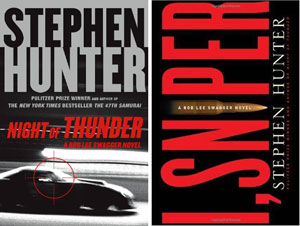
“Night of Thunder” (2008) takes place in Bristol, Tennessee, just before the big Bristol NASCAR race. Pam and I visited the Bristol track a few years ago on vacation. It’s truly an amazing track, and I could only imagine the excitement around the race. This book brings out that excitement.
Stephen Hunter has written three books starring Earl Lee Swaggard, a WW2 Medal of Honor winner and southern sheriff. He’s a fine creation, as hard as they come, maybe as tough as Jack Reacher. But Hunter’s best creation is Bob Lee Swaggard, Earl’s son. Bob is a master sniper, with the third-highest number of confirmed kills (86) in Vietnam.
Thus far, Hunter has written 6 books starring Bob Lee, with a 7th due in December 2011. I’ve read them all, starting with 1993’s “Point of Impact” (the basis of the movie “Shooter,” starring Mark Wahlburg). Probably my favorite was the 4th book, “The 47th Samurai,” which masterfully alternated between Earl on Iowa Jima and Bob in present-day Japan. That book came out in 2007, nine years after his previous Bob Lee book (“Time to Hunt,” from 1998). But Hunter has now cranked out a new Bob Lee book every year.
“Night of Thunder” (2008) finds Bob Lee’s daughter, a reporter in Bristol, run off the road in an attempt to kill her; she spends most of the book in a coma. That brings Bob Lee to Bristol, and he sets about determining who tried to kill his daughter. The cast of characters includes a woman deputy who is a crack shot, a Nascar racer, a clerk at Lester’s convenience store, FBI agent Nick Memphis (who traces back to the first Bob Lee book), and the Grumleys, a clan of criminals and killers led by a charlatan preacher. The Grumleys are planning something epic at the race,
Bob Lee is now in his early 60s, with a pronounced limp thanks to both a sniper’s bullet and a sword wound the year before (from “47th Samurai”). But he’s still tough as nails, and don’t mess with his daughter. Obviously, I can say without spoiling anything, Bob Lee figures things out, saves the day, and exacts vengeance. That’s what happens in all Stephen Hunter books.
“I, Sniper” (2009) begins with Carl Hitchcock, the number two sniper from Vietnam, being framed for the sniper killings of four anti-Vietnam activists (in real life, Carlos Hathcock recorded 93 kills in Vietnam, the 4th highest total). Hitchcock is then found dead, an apparent suicide, in a motel room. Bob Lee Swaggard is brought in to confirm that it was, indeed, Hitchcock who carried out the executions. Predictably, he determines that Hitchcock wasn’t the shooter, and that he didn’t commit suicide. And predictably, nobody believes him.
The first person killed was Joan Flanders, who is a clone of Jane Fonda. Every detail about Joan–physique, actor father, Oscar, anti-Vietnam activism (complete with photo sitting at a Vietnamese anti-aircraft gun), workout videos, marriage to a media tycoon–everything is exactly Jane Fonda. In light of the attack on Congresswoman Gabby Giffords and the “targeting” by Sarah Palin et al (after this book was published), I must say that it felt both uncomfortable and inappropriate. Hunter didn’t need to get so specific. He was, it seemed, condoning the idea of assassinating Jane Fonda. But I digress. Back to the plot.
Swaggard puts the FBI team on the right trail, and even goes undercover. But the investigation is derailed by T. T. Constable (Ted Turner–get it?), Joan’s ex. He wants the investigation shut down, and uses his connections to make it happen.
The plot increasingly surrounds Constable and his motives for shutting down the investigation, but also involves a team of bad-boy Irishmen who are former British SAS snipers, two of the other assassination victims (also anti-Vietnam activists), and Nick Memphis, the FBI agent in charge of the investigation (who also made an appearance in “Night of Thunder”).
Both books were very good, typical Hunter fare. I suppose I liked “Night of Thunder” better, but “I, Sniper” had a more interesting ending. “The 47th Samurai,” and probably “Point of Impact” (my memory is fading) were better yet.
 The 2011 update of “Footloose” not only follows the plot of the 1984 version, but pays respectful homage to the original in various ways–from the sameness of the characters, to Ren’s attire at the concluding dance, and to the final dance shot, which is taken right from the original.
The 2011 update of “Footloose” not only follows the plot of the 1984 version, but pays respectful homage to the original in various ways–from the sameness of the characters, to Ren’s attire at the concluding dance, and to the final dance shot, which is taken right from the original.
Yet, it’s also a different movie. In the 1984 movie, Bomont is a town that is simply behind the times; dancing was never allowed. But the 2011 version begins with a high-energy teen dance in Bomont. Five teens, who had been drinking, leave the dance and are killed in a head-on with a semi. That prompts the town to over-react by outlawing a wide range of activities in an effort to protect their children. Dancing and loud music are casualties.
Three years later, Boston boy Ren McCormack arrives in town to live with an aunt and uncle following the death of his mother (in the original, his family simply moved to Bomont). He arrives with plenty of angst and pent-up grief which, in this story of big-city boy comes to backwards small town, easily carries the appearance of rebellion. There’s a lot of James Dean here.
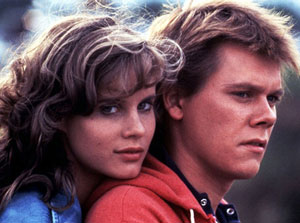
Kevin Bacon and Lori Singer, from the 1984 version.
The role of Ren made Kevin Bacon famous. This time, Ren is played by Kenny Wormald, whose previous acting credits include pretty much nothing. He’s not near the actor Bacon was, but boy, can he dance! He didn’t need a double, like Bacon did. However, a complaint: whereas you saw the joy of dancing in Bacon (and his double), Wormald’s dancing was much more serious. But alas, I’m being petty. I loved watching Wormald dance.
Julianne Hough, of Dancing with the Stars fame, did well in the role of Ariel Moore, the preacher’s daughter. She was more of a wild child than Lori Singer’s Ariel in the original, but there was a reason for that. Again, Singer was a better actress, but Hough can really dance–though this movie seemed more interested in eye candy than in showcasing her dancing ability.
Chris Penn killed with the role of Willard in the original…as did Miles Teller in the remake. That one’s a wash, if not tilted toward Teller.
Dennis Quaid had the misfortune of following John Lithgow in the role of Rev. Shaw Moore. He gave a strong performance (in the remake, Moore’s son was among the five teens killed). However, Lithgow absolutely nailed the role and defined it. I remember when Quaid played Doc Holliday in the movie “Wyatt Earp,” which came out the same summer as “Tombstone,” a movie in which Val Kilmer totally blew me away with his Doc Holliday. Quaid is condemned to be a commendable second.
They found a high-powered actress in Andie McDowell to play the minister’s wife. Dianne Wiest was far better in that role, as were her scenes with daughter Ariel and with her husband. McDowell played pretty much the same character, with the same scenes, but she succeeded in coming across as terribly bland.
Back to the story.
In short, the 2011 Footloose embraces everything good about the original, but updates it for today’s audiences.
One scene they left out, and which I was waiting for, came at the end of the original. It was when Rev. and Mrs. Shaw drove out to a place overlooking where the dance was being held and had a sweet scene together. They skipped that, and I missed it. I’ll bet they actually filmed it, but decided to cut it from the final release. Look for it in the DVD extras.
The 1984 Footloose is a classic, no doubt about it. The 2011 version is in no way a classic. But it stays true to the story of the original, and in so many ways pays tribute, recognizing it as a classic. It does what a remake should–updates a great story for a new generation. Too many directors get way too clever trying to inject their own twists on the plot. Director Craig Brewer–I commend your restraint.
1 Comment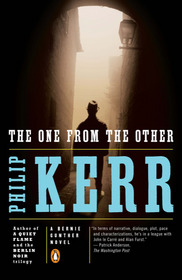 “The One from the Other” is book 4 of what began as a well-known set of books called the Berlin Noir Trilogy, which Philip Kerr wrote 1989-1991.
“The One from the Other” is book 4 of what began as a well-known set of books called the Berlin Noir Trilogy, which Philip Kerr wrote 1989-1991.
The books center on Bernie Gunther, a private detective in Germany. All three books plunge us into involved murder mysteries, which are good enough on their own. Then you add the historical context, with all of these things happening in Nazi Germany in the background, and the books become (at least to me) utterly fascinating.
We first meet Gunther in “March Violets,” as the 1936 Summer Olympics are underway in Berlin. Then comes “The Pale Criminal,” set in 1938 as war looms. Then we jump ahead to 1947, to post-war Vienna, where Gunther tries to free a friend accused of murdering an American officer in a city divided between the Allies and the Russians (the “Ivans”). All three books are murder mysteries.
After 1991, Philip Kerr wrote a number of other books. But in 2006, he returned to the saga of Bernie Gunther, and has now written five more Gunther mysteries (“Prague Fatale” is due in October 2011).
“The One from the Other” occurs during 1949, amidst the complicated politics of Allied and Russian occupation, German reconstruction, and the continuing war trials. Gunther is asked to find a woman’s husband, whom she admits was a sadistic war criminal, to confirm whether or not he is dead. But nothing is simple in post-war Europe, with all kinds of groups competing for influence, spoils, survival, and power.
The plot is quite complicated, though you don’t realize it until you’re far into the book and discover that everything that seemed straightforward is actually a whole lot more complex than you thought. Gunther encounters SS war criminals on the run, shady Americans, and Israeli death squads. He gets beat up, he gets deceived and used–not at all an invincible hero type–and yet he finds a way. Put him in an American context, and he could be Philip Marlowe.
The ending is quite unexpected, and yet everything is wrapped up neatly. The ending also made me want to immediately begin reading the next book, “A Quiet Flame,” which finds Gunther in South America. That should be interesting.